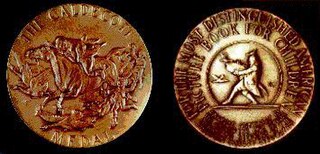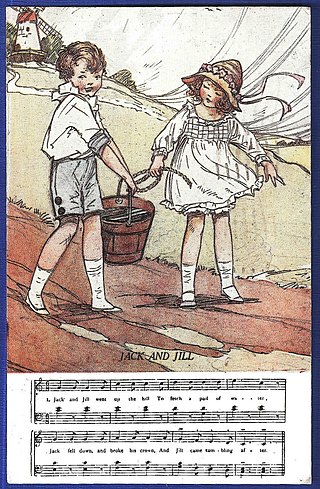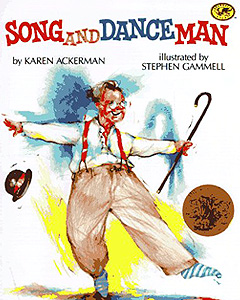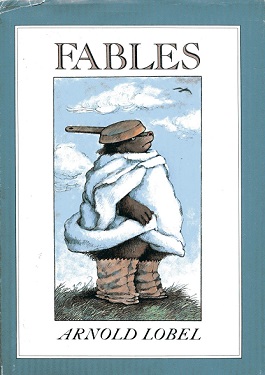
The Randolph Caldecott Medal, frequently shortened to just the Caldecott, annually recognizes the preceding year's "most distinguished American picture book for children". It is awarded to the illustrator by the Association for Library Service to Children (ALSC), a division of the American Library Association (ALA). The Caldecott and Newbery Medals are considered the most prestigious American children's book awards. Beside the Caldecott Medal, the committee awards a variable number of citations to runners-up they deem worthy, called the Caldecott Honor or Caldecott Honor Books.

"Jack and Jill" is a traditional English nursery rhyme. The Roud Folk Song Index classifies the commonest tune and its variations as number 10266, although it has been set to several others. The original rhyme dates back to the 18th century and different numbers of verses were later added, each with variations in the wording. Throughout the 19th century new versions of the story were written featuring different incidents. A number of theories continue to be advanced to explain the rhyme’s historical origin.

"Ring a Ring o' Roses", "Ring a Ring o' Rosie", or "Ring Around the Rosie", is a traditional nursery rhyme, folk song and playground singing game. Descriptions first emerge in the mid-19th century, but are reported as dating from decades before, and similar rhymes are known from across Europe. It has a Roud Folk Song Index number of 7925.

Drummer Hoff is the title and main character of a children's book by Barbara and Ed Emberley. Ed Emberley won the 1968 Caldecott Medal for the book's illustrations. Written by Barbara Emberley, it tells a cumulative tale of seven soldiers who build a cannon named "Sultan", and Drummer Hoff, who fires it off, with the book exploding into a blast of colors. The last picture shows the exploded cannon at a future point in time among wildflowers and birds. The illustrations evoke both 1960s psychedelica and Colonial American engravings. In 1969 it was transformed into an animated 6 minute theatrical short, directed by Gene Deitch and produced by Morton Schindel of Weston Woods Studios. It was released on DVD in 2008.

"This Is the House That Jack Built" is a popular English nursery rhyme and cumulative tale. It has a Roud Folk Song Index number of 20854. It is Aarne–Thompson–Uther Index type 2035.

Ed Tse-chun Young is a Chinese-born American illustrator and writer of children's picture books. He won one Caldecott Medal for the year's best American picture book and for his lifetime contribution as a children's illustrator he was twice the U.S. nominee for the Hans Christian Andersen Award.

David Díaz is an American illustrator of children's books. He won the 1995 Caldecott Medal for U.S. picture book illustration recognizing Smoky Night by Eve Bunting. He lives in Carlsbad, California.

Song and Dance Man is a children's picture book written by Karen Ackerman and illustrated by Stephen Gammell. Published in 1988 by Knopf Books, the book is about a grandfather who tells his grandchildren about his adventures on the stage. Gammell won the 1989 Caldecott Medal for his illustrations, pencil drawings using full colors.

Maud Fuller Petersham and Miska Petersham were American writers and illustrators who helped set the direction for illustrated children's books that followed. The Petershams worked closely with such pioneering children's book editors Louise Seaman Bechtel and May Massee, and with such innovative printers as Charles Stringer and William Glaser. They worked as a seamless partnership for more than five decades. Both prolific and versatile, they produced illustrations for more than 120 trade and textbooks, anthologies, and picture books. Of the 50 books they both wrote and illustrated, many were recognized with important awards or critical acclaim. They are known for technical excellence, exuberant color, and the introduction of international folk and modernist themes.

The Egg Tree is a 1950 book by Katherine Milhous that won the 1951 Caldecott Medal. It is based on the author's family tradition and tells the classic tale of a Pennsylvania Dutch Easter, with its main characters being Katy and Carl. One day, near Easter, they look for Easter eggs and found eggs that their grandmother had painted on a tree. They are interested, so they ask their grandmother about the eggs. They eventually create one, and it becomes a big success the next Easter.

The Girl Who Loved Wild Horses, written and illustrated by Paul Goble, is a children's picture book originally released by Bradbury Press in 1978. It was the recipient of the Caldecott Medal for illustration in 1979. As of 1993, the book has been published by Simon & Schuster.

Fables is a children's picture book by American author Arnold Lobel. Released by Harper & Row in 1980, it was the recipient of the Caldecott Medal for illustration in 1981.

Good Masters! Sweet Ladies! Voices from a Medieval Village is a 2007 children's book written by Laura Amy Schlitz. The book was awarded the 2008 Newbery Medal for excellence in children's literature.

The Lion & the Mouse is a 2009 nearly wordless picture book illustrated by Jerry Pinkney. Published by Little, Brown and Company, it tells Aesop's fable of The Lion and the Mouse. In the story, a mouse's life is a spared by a lion. Later, after the lion is trapped, the mouse is able to set the lion free. Adapting the fable, with the moral that the weak can help the strong, as a wordless picture book was seen as a successful way of overcoming the brief plot generally found in the source stories. While it was Pinkney's first wordless picture book, it was not the first time he had told the story, having previously included it in his Aesop's Fables, published in 2000. Pinkney, who had received five Caldecott Honors, became the first African American to win the Caldecott Medal for his illustrations in the book. His illustrations were generally praised for their realism and sense of place. The cover illustrations, featuring the title characters but no text, drew particular praise.

A Sick Day for Amos McGee is a 2010 children's picture book written by Philip C. Stead and was illustrated by Erin E. Stead. The book, published by Roaring Brook Press, depicts a zookeeper who has bonded with the animals he cares for and who come and visit him one day when he gets sick. Phillip Stead wrote the book hoping his wife Erin would illustrate it after a period where she had become discouraged with her art. The book was well reviewed, and Erin won the 2011 Caldecott Medal for her illustrations. The book received praise for its woodblock illustrations and for its message about what friends will do to help and support each other.

In the children's picture book Chanticleer and the Fox, Barbara Cooney adapted and illustrated the story of Chanticleer and the Fox as told in The Nun's Priest's Tale in Chaucer's Canterbury Tales, translated by Robert Mayer Lumiansky. Published by Crowell in 1958, it was the recipient of the Caldecott Medal for illustration in 1959. It was also one of the Horn Book "best books of the year".

This Is Not My Hat is a 2012 children's picture book by the author and illustrator Jon Klassen. The story is told through the unreliable narration of a little fish, who has stolen a hat from a big fish and how the big fish reacts to the theft. It is a thematic follow-up to I Want My Hat Back and was meant to be a more literal sequel until Klassen took a suggestion to change which animals were in the story. The book was well received by critics who praised its dark or ironic humor which could only be understood by comparing the words of the little fish's narration against the events of the illustrations. In addition to several positive reviews, Klassen won the 2013 Caldecott Medal and the 2014 Kate Greenaway Medal becoming the first book to win both awards. This is Not My Hat was also a commercial success.

Radiant Child: The Story of Young Artist Jean-Michel Basquiat is a 2016 picture book biography by Javaka Steptoe about Jean-Michel Basquiat. Using a style similar to Basquiat's, the book tells the story of his childhood and early career. It won the 2017 Caldecott Medal and Coretta Scott King Illustrator Award for its illustrations.

Alma and How She Got Her Name is a 2018 children's picture book by Juana Martinez-Neal. Alma, whose full name is Alma Sofia Esperanza José Pura Candela, thinks she has too many names and so she asks her dad about them. He explains the various people she was named to honor. The book was spurred by Martinez-Neal's Peruvian immigrant experience and the birth of her children. The book was well reviewed and a recipient of a 2019 Caldecott Honor for its illustrations. The graphite and colored pencil illustrations feature only a few colors, including blue and pink. Martinez-Neal hoped to evoke the feel of a photo album, in keeping with the book's theme of family.
An American ABC is a 1941 picture book by Maud and Miska Petersham. It is an ABC book of Americana. The book was a recipient of a 1942 Caldecott Honor for its illustrations.



















